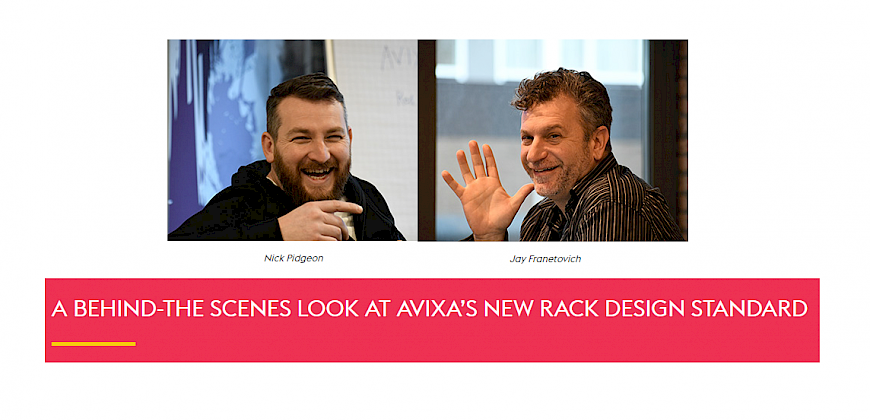Maidenhead, United Kingdom

The AVIXA® Rack Design for Audiovisual Systems standard completes the pair of standards aimed at formalizing guidelines for efficient design and integration of racks in AV systems.
Published in May 2020, the new standard follows the 2016 Rack Building for Audiovisual Systems standard. Rack Design for Audiovisual Systems sets out the minimum requirements for audiovisual rack planning, design, accommodation, and equipment layout.
Co-moderating the task group that developed the standard are Jay Franetovich, CTS®, Product Manager at Middle Atlantic Products, Legrand AV Division, and Nick Pidgeon, CTS, Managing Director of U.K.-based Visualization Limited. Here they offer some insight into the new standard and how it was developed.
Please explain the history of the rack design standard and the need for a second standard for AV racks.
 Nick Pidgeon
Nick Pidgeon
Nick Pidgeon: I think of the rack design standard like the Star Wars movies — design is actually the prerequisite piece to the build. When we were working on the rack building standard, which we did first, design decisions kept coming up, and we had to keep reminding ourselves that we were writing a build standard, and that design issues were out of scope. We discussed delivering a combined standard, but in the interests of getting the ‘build’ part out there, we decided to create two standards and began work on the ‘design’ piece immediately after publication of the rack building standard.
Who is the standard aimed at?
Jay Franetovich: It can be used by all parties affiliated with the building phase – consultants, system designers, system engineers, manufacturers, technology support staff, end users, and verification agencies.
Nick Pidgeon: It still has relevance to the rack build team to sanity check what they’ve been given, but we found that quite often the people building the racks were designing them during the build stage, which is an inefficient way of working. The system design should have been thought about and done before the rack design.
Who do you anticipate will adopt the standard?
 Jay Franetovich
Jay Franetovich
Jay Franetovich: Well, we hope everyone that has an AV system rack! While it’s geared toward the mid- to large pro designers, anyone with AV equipment that will be put into a rack has something to gain by following the requirements.
What does the standard address and what does it not address?
Jay Franetovich: The standard covers all the inputs necessary to consider when designing the AV system rack. Successful rack integration depends on design documentation that is created from methodical evaluation of the complexities of the AV system (inputs) and then accurately hands down that information to the installer (outputs). The standard includes checklists and graphics to help the designer accomplish this.
The exceptions listed in the standard include any equipment that isn’t located within the AV rack or AV racks that have requirements for extreme conditions, which would be things like extreme temperatures or altitudes.
Nick Pidgeon: A key component is the thermal management of the system. If a rack is poorly designed you end up with too much equipment in too small of a rack, and then you’ll have thermal management and serviceability issues as well as efficiency issues within the build. Another key piece is connecting the rack to the site cabling; there are various different ways to do it. What it doesn’t address is system design. It’s a rack design standard. It’s also not guidance: it’s not how to do it, it’s how it needs to be.
What are the primary benefits of the standard?
Jay Franetovich: Key benefits are ensuring that the system you’re designing is well built, and looking at all aspects — cable management, thermal management, power, and so on — and making sure you have a reliable system. The other part is serviceability. A lot of times the person who builds and who services the rack are two different people; if everything’s done to the standard, even if you didn’t build it, it will be familiar, because the person who built it followed the standards.
One of the biggest things for me is that it is a standard. It’s a big step forward for the AV world to have these standards. Having experience in data and structured cabling, where everything is standards based. It has been exciting to help pioneer some of the standards for AV.
Nick Pidgeon: For me it comes down to the efficiency of the build and the future serviceability. Thermal management and serviceability go hand in hand. If the thermal management is poorly addressed, then the system’s longevity will fall over. And if there is overcapacity — too much equipment within the rack — it’ll be hard to get to the equipment to service it.
Why was it important to have the standard at this particular time?
Jay Franetovich: I think it’s long overdue. With rack build, we’ve seen the market really explode over the last five or six years. The customer base expects standardization, particularly when there are people from other industries doing multiple aspects in a job.
Nick Pidgeon: Both rack standards were long overdue. As an industry we’ve been building racks for a long time. Similar industries have had standardization on these systems for years; in our industry it’s been a by-product of the system installation.
What kind of diversity do you have in the team that is developing the standard, and what specifically do you bring to the table?
Jay Franetovich: This is a global standard, so it was important to have team members from a variety of regions. In the task group we have people from the U.K., EU, Singapore, Asia-Pacific, as well as from the United States. We have myself as a rack manufacturer, someone else who runs an AV department at a large university, an installer — it’s definitely a diverse group. What I bring is the manufacturing portion of it: the product that’s being built as well as the application to how the products are being used in the market.
Nick Pidgeon: The diversity in the group has been great. We have Jeroen Oey who’s in the European Commission, and he’s used to seeing racks in commission rooms that are temperature controlled, he’s used to the perfect side of it. We have Greg Carstens, who’s the AV manager at the University of Colorado Boulder, and he sees a very different type of rack to Jeroen. For the two of them to align it took a few meetings to understand the interpretation of a rack and how it was to be installed. Then we have Kenneth Ng in Asia and he has to consider the humidity in the rooms the racks are being installed in. It’s real-world input from these people. And that’s the intention of the diversity within the group. It challenges us to give the standard the best value for everyone.
My expertise is building the racks, so I bring to the table what would I like to happen. It’s amazing how often we have to ask for a rack elevation and system design, and ask how they are connecting it to the site. These are questions we need to have answers to early on. There are some 60 considerations to think about. That’s what we live and breathe, day in and day out, it’s our business. The rest of the team are designing the systems or having the systems designed.
More on the Rack Design for Audiovisual Systems standard.
Explore all of AVIXA’s AV standards.
Task Group Members
- Jay Franetovich, CTS, Product Manager, Middle Atlantic Products, Legrand AV Division
- Nick Pidgeon, Managing Director, Visualization Limited
- Greg Carstens, CTS-D, CTS-I, Senior Audio Visual Design Engineer, University of Colorado Boulder
- Jason Brameld, Group Technical Director, Torpedo Factory Group
- Jeroen Oey, CTS, Maintenance Manager, Quality Assurance, Standards Development, European Commission
- Kenneth Ng, Managing Director, Mojoworx Asia
- Loanna Overcash, AStd, Standards Developer, AVIXA
- Ann Brigida, CTS, CStd, Senior Director of Standards, AVIXA



